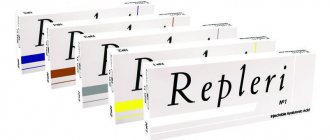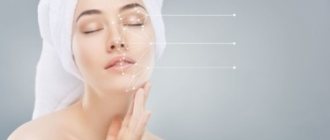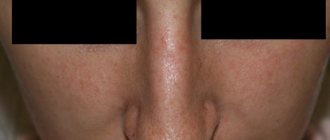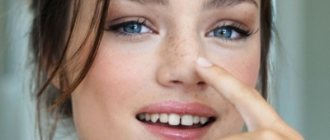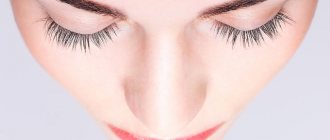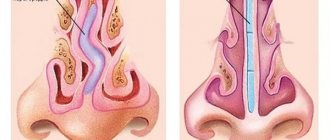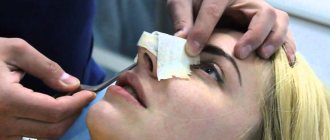Rhinoplasty is rightfully considered one of the most difficult plastic surgeries. After all, not only the aesthetics of the face, but also the respiratory function of the nose depends on its result. We talked with plastic surgeon Konstantin Aleksandrovich Matveev and found out what types of surgery exist and what is important for patients to know about if they are planning nose correction.
What does rhinoplasty involve?
Rhinoplasty is a surgical or injection method to correct deformities or imperfections in the shape of the nose. It also includes complex operations to completely restore the nose.
The human nose is a complex organ that is responsible for many tasks: from breathing to proper metabolism.
It has a complex structure of the nasal and frontal bones, large, small, lateral and accessory cartilages, therefore various types of rhinoplasty affect all parts of the organ.
With the help of such a surgical intervention, the nose is made proportional, straighter, thinner, with a clearly defined bridge of the nose, neat wings and nostrils, and a small tip.
Do not confuse rhinoplasty and septoplasty. In the second case, surgery is performed to correct the nasal septum. The goal of the intervention is to improve breathing. But rhinoplasty is performed for aesthetic reasons.
Plastic surgeon Dhaval Patel
High-quality rhinoplasty visually transforms a person, making his facial features more harmonious, thinner, and more aristocratic.
Problems of both aesthetic and medical nature are corrected, as can be seen in the “before and after” photos on the Internet.
Only qualified doctors - plastic surgeons with many years of experience - can perform rhinoplasty.
The fact is that nasal correction requires great responsibility from the specialist, otherwise the risk of encountering an unsuccessful result increases.
When can repeat surgery be performed?
Revision rhinoplasty is performed in two cases:
- Firstly, during the initial operation the task was not fully solved.
- Secondly, complications arise during or after surgery.
The reasons that led to revision rhinoplasty can be divided into several groups:
- Technical errors.
- Incorrect readings.
- Defects in aesthetic evaluation.
- Complications.
Deformities that require repeated intervention:
- Saddle deformity.
- Deformation of the wings of the nose.
- Deformation of the upper lateral cartilages and bones of the nose.
- Supratip elevation.
- Thick, unyielding tip.
- Deformation of the area of skin and cartilage that separates the nostrils (columella).
- Short nose.
- Deformation of the nasolabial angle.
- Uncorrected deformity of the nose, Pinocchio type.
We talked in more detail about the reasons and ways to avoid unsuccessful rhinoplasty and what to do after a poorly performed operation here.
Also, if there are functional problems, it is necessary to resort to revision rhinoplasty. For effective re-plasty it is necessary to follow several basic principles:
- How soon can a repeat operation be performed? The operation should be performed only after the tissue edema has completely subsided (at least 12 months).
- Correct diagnosis is the key to success.
- Reduce the amount of tissue dissection.
- Use only autoplastic materials.
Rhinoplasty is a complex operation, but if you are in the hands of an experienced master, then there is nothing to worry about.
You can find more information about the pros and cons of thread and non-surgical rhinoplasty on our website.
We invite you to watch a video about the nuances of revision rhinoplasty:
Features of the operation
You should know that surgical rhinoplasty involves making incisions with a scalpel to reshape the open nasal cavity by moving or partially removing cartilage.
The doctor must take a responsible approach to all stages of the operation.
According to the American Society of Plastic Surgeons, rhinoplasty ranks third in popularity among all cosmetic surgeries.
Plastic surgeon Smita Ramanadham
The nose is the organ responsible for breathing, which indirectly affects the proper oxygen saturation of the blood and, accordingly, metabolic processes throughout the body.
Modern correction methods often combine not only aesthetic correction of the shape, but also restoration of correct nasal breathing.
You should contact trusted specialists.
There are cases when women went to clinics where would-be specialists not only did not solve the patients’ problems and even worsened the shape of the nose instead of correcting them, but also damaged some of the tissues and provoked extensive swelling of the face with their actions.
Don’t forget that there is a vital organ nearby – the brain.
High-quality surgery is only possible in specialized clinics - you should carefully study reviews on the Internet and seek advice from the most reliable specialists.
Other correction methods. Why rhinoplasty is the most reliable method
To correct the nose, surgeons use different surgical techniques depending on the wishes of the client and the result that the patient expects to receive. However, you can find other methods for correcting the tip of the nose on the Internet.
Clamps
In online stores you can find so-called “nose correction clips”. Manufacturers assure that when wearing correctors 2-3 times a day, an effect will be noticeable, comparable to surgical intervention. But, naturally, this is far from the truth. No clamps or other devices from pseudo-specialists are suitable for nose correction. If there is any effect, it will be short-term - for 2-3 weeks, and the correction is insignificant.
Exercises
There is a set of exercises for the face that allows you to adjust its shape. These exercises are useful for maintaining muscle tone, correcting cheekbones and double chin, but they will not correct the shape of cartilage. The effect after systematic exercise lasts for 2 weeks.
Correction with threads
The thread technique is carried out by a specialist with a special needle through micropunctures. Specially designed threads with notches are inserted into the skin of the nose to form a frame. The threads are inserted through small punctures, and the frame keeps it in the desired position. After two days, the doctor removes the ends of the threads and the patient sees the final result, which lasts about 3 years.
Use of hormonal drugs
To correct the tip of the nose, you can also take a course of hormonal medications. First of all, you need to consult an endocrinologist. If there are no contraindications, a hormonal drug can be administered. This procedure is performed to remove excess soft tissue and elevate the tip. For correction, you need to undergo a course of procedures that will last from 2 to 3 weeks. It is worth noting that the drugs provide a temporary effect - from 3 months to 2 years, depending on the drug chosen.
Surgical correction
According to experts, rhinoplasty is the most reliable and effective method of correction. Unlike previous methods, rhinoplasty provides lifelong results. Plastic surgery lasts 1–2 hours under local anesthesia or general anesthesia. Main advantages of the operation:
- all possible correction options (lower or raise the tip, reduce, straighten or narrow the tip of the nose);
- eliminating breathing problems;
- lifelong outcome;
- correction of injuries and birth defects.
Cost of rhinoplasty
The cost of services in Moscow and St. Petersburg is approximately the same. It is not free under insurance. Average price for each type of rhinoplasty:
- Non-surgical (without surgery) – from 500 rubles. in one procedure;
- Reconstruction of the form - from 32 thousand rubles;
- Shape reduction – from 9 thousand rubles;
- Post-traumatic recovery – from 300 thousand rubles;
- Flap rhinoplasty according to Converse – from 92 thousand rubles.
Remember that fillers will not make your nose appear smaller. The doctor will be able to change the proportions, which can visually improve the situation.
Plastic surgeon Andrew Miller
Private method
Closed rhinoplasty is also widespread because it makes it possible to achieve the desired result without visible signs of surgery.
The main distinguishing feature of this method is minimal tissue damage; the incisions are made inside the nose, the columella is not damaged.
The main advantages of the closed method:
- minimal tissue trauma and short rehabilitation period;
- absence of visible traces of the operation;
- since the incisions are closed with self-absorbing threads, there is no need to remove sutures;
- high predictability of the result obtained;
- the integrity of the blood vessels ensures normal nutrition of the tissues and skin of the nose.
Disadvantages of closed rhinoplasty:
- The surgeon must be highly qualified and have extensive experience, since the operation is performed almost blindly.
- Operations performed using a closed technique do not make it possible to solve all problems of an aesthetic and physiological nature.
- It is difficult to achieve symmetry, especially if the skin is thick.
The technique and type of operation are determined by an experienced surgeon, as a result of which the desired result is achieved.
Don’t miss the most popular article in the section: Vera Alentova after plastic surgery - the latest photos, what operations were performed, how the star has changed.
Types of rhinoplasty
Modern plastic surgery offers several options for correcting the shape of the nose.
Based on the wishes of the client, the physiological characteristics of the nasal cavity and cartilage, medical indicators, and an assessment of the amount of work, you can choose one or another method of performing the operation.
For minor defects, it is recommended to correct the shape using injections rather than surgery.
| View | general information | The essence of the operation |
| Closed rhinoplasty | As a minimally invasive technique for correcting the shape of the nose, closed surgery is the most effective. Recommended for correcting small shape defects, such as a saddle-shaped tip of the nose. Main advantages: low likelihood of edema, low trauma, minimal risk of complications. | The surgeon makes small incisions inside the nasal cavity and then closes them. The outer skin is not affected. |
| Open rhinoplasty | A complex method of correction that requires a lot of experience and skill from the surgeon. Required for severe bone deformations after mechanical impact, lateral or superior curvatures, and if it is necessary to use grafts. The method is also used for osteotomy. | Incisions are made in the fold between the nostrils, thanks to which the skin is separated from the cartilage. Next, the surgeon performs the necessary manipulations. |
| Non-surgical (injection) rhinoplasty | The most modern and safe way to improve your appearance with contour rhinoplasty. It is recommended to carry out procedures once every 1-2 years. | The cosmetologist uses injections of fillers - gel or liquid preparations based on hyaluronate. The substance fills the necessary cavities and corrects imperfections in the shape of the back, tip, nostrils or any irregularities. |
After closed rhinoplasty, scars are not visible at all, but after this type of intervention there is more swelling when compared with the open technique.
Plastic surgeon Ronald Schuster
What kind of anesthesia is given?
- Most often, the operation is performed under endotracheal anesthesia (general anesthesia).
Since it is the safest and most manageable type of pain relief. Endotracheal anesthesia allows you to work with the nasal septum. To achieve vasoconstrictor and anesthetic effects of the nasal mucosa, a solution of dicaine is applied 30 minutes before surgery. And in order to prevent bacterial complications, a broad-spectrum antibiotic is administered intravenously 20 minutes before surgery. - Local anesthesia also takes place in rhinoplasty.
Before performing local infiltration anesthesia for plastic surgery, it is recommended to perform conduction anesthesia. In this case, the infraorbital, supratrochlear nerves and the external nasal branch of the ethmoidal nerve are blocked. As a result, anesthesia becomes longer, and in the early postoperative period the pain threshold is reduced and the development of tissue edema is prevented. For local anesthesia, use a 1% solution of lidocaine with adrenaline.
Indications and contraindications
Women strive to improve their appearance, and if the shape of their nose seems imperfect to them, then they can resort to plastic surgery or filler injections.
Indications can be divided into two types - medical and aesthetic. The following factors are considered medical.
INDICATIONS
- Curved cartilaginous septum, making breathing difficult and causing swelling of the airways when exposed to temperature;
- Post-traumatic deformation of shape, curvature or displacement of cartilage;
- Birth defects that make breathing difficult.
Aesthetic indications are very conditional and are not direct indications for surgery, except in obvious cases of disproportion.
INDICATIONS
- Wide nostrils or back;
- Large tip of the nose (“potato”);
- The presence of a pronounced hump;
- Lack of pronounced bridge of the nose;
- Hooked nose, with a downturned tip;
- Snub nose.
Operative types of rhinoplasty have many contraindications.
CONTRAINDICATIONS
- acute infections;
- malignant tumors;
- herpes;
- low blood clotting;
- acute rhinitis;
- heart diseases;
- pyelonephritis;
- mental disorders.
Also, you cannot adjust the shape of the nose during pregnancy and breastfeeding, as well as during menstruation.
Analyze your attitude towards appearance and decide whether surgery is really required or whether you are ready to accept yourself with natural beauty.
Pros and cons of non-surgical rhinoplasty
The advantages of the non-surgical method of nose correction are obvious: firstly, it is very fast. If a surgical operation lasts on average two hours, then a botulinum toxin injection to lift the tip of the nose takes one minute, and correcting a hump will take 15 minutes.
The advantages include the rather long-lasting effect of such plastic surgery, even in comparison with other cosmetic procedures. For example, the same filler applied to the lips and nose behaves completely differently. It can “go away” from the lips in six to eight months, but in the nose it can remain for up to two years. This happens because the lips are more mobile and have very good blood flow. As for fillers, they can last much longer - two or three years.
Among the disadvantages, it should be noted the danger of introducing drugs into the correction area, especially if it was previously injured. This risk always exists. And, of course, there is no one hundred percent guarantee that the cosmetologist will get the result desired by the patient.
“At the same time, if the result is 20–30%, then this is immediately noticeable. We show the patient his profile photo, the changes are obvious, and, of course, the patient is very happy when he sees the transformation, especially if he has had this defect all his life,” adds Isabella Airapetova.
Preparation for rhinoplasty
The operation is preceded by a preparatory period:
- The plastic surgeon must consult the patient and prepare him for surgery by discussing his wishes, studying his health, and explaining the nuances of creating a “new” nose.
- Before plastic surgery, you should undergo a series of standard examinations, which include a general blood test and biochemistry, an ECG and a consultation with a therapist.
- If the patient has no contraindications, then he is sent to a day hospital.
- 10-15 days before admission to the hospital, the clinic client needs to give up alcohol, smoking, heavy food, maintain a diet and sleep schedule.
- A few hours before the start, the consumption of food and water is excluded - violation of this rule can lead to negative consequences of surgical intervention.
- If you plan to completely correct the shape or correct serious defects, before rhinoplasty you must attend a consultation with an anesthesiologist - a complex operation will be performed under general anesthesia and requires testing for intolerance to the components of anesthesia. Defects in the shape of the nasal tip are corrected under local anesthesia.
There are cases when anesthesia leads to side effects. This is vomiting, nausea, sore throat.
Anesthesiologist Monica Soni
To prevent plastic surgery from seeming so frightening, doctors recommend watching topical videos on the Internet, reading more materials about rhinoplasty, and setting yourself up for a positive result.
Can any nose shape be made “to order”, for example, based on fashion trends?
As with other plastic surgery, trends in rhinoplasty exist. Today, social networks play a big role in creating “fashionable” nose trends. Unfortunately, patients do not always understand that photographs on the Internet are a lot of artistic work, a high percentage of retouching, corrections, correct lighting, and the work of a stylist and makeup artist. It doesn't look like this in real life. “We have to explain that these “sharpener” noses are not so good in real life,” explains the expert.
If the patient came with a specific ideal vision of his nose, for example, brought a photo of his favorite actor, then the surgeon, of course, will do everything to come as close as possible to the desired shape. But a lot also depends on the initial data and anatomical features of the patient. If, for example, a person has thick, porous skin, and he wants a chiseled small nose, like on Instagram, then such a result is hardly achievable.
How is the operation performed? (stages)
Surgical types of rhinoplasty consist of several stages:
- The anesthesiologist administers local anesthesia to the patient for minor surgical interventions or administers general anesthesia for more complex cases of cartilage deformation. Additional anesthesia may be performed to disable the receptors.
- In the area of the columella, between the nostrils, a thin incision is made with a scalpel and the operation itself begins - open or closed. In the first case, the surgeon frees the cartilage from the skin, in the second, he performs the necessary manipulations without temporarily removing the skin.
- Using surgical instruments, the doctor corrects defects discussed with the patient. If necessary, implants are inserted into the cartilage area or, on the contrary, part of the tissue is removed. The average operating time range is 50-120 minutes.
- Upon completion of the procedure, stitches are applied and the nose is closed with a fixing bandage. Non-operative rhinoplasty options for correcting small areas of the nose require only local anesthesia or are performed without it, so the correction consists of three stages - preparatory, injection and restorative. If necessary, the injection is repeated.
Protect yourself for a couple of weeks from sports activities where you can injure your nose.
Plastic surgeon Arnold Almonte
The most progressive method of correcting defects in appearance is laser - this tool replaces a scalpel, reduces blood loss and promotes rapid tissue healing. Find out more about the nuances of the procedure during a consultation with your plastic surgeon.
Public method
Plastic surgery to change the shape or reduce the size of the nose is most often performed using the open method. The essence of this method is to make an incision at the edge of the wing cartilage and an incision along the columella. When the surgeon has made the incisions, the skin is retracted to the bridge of the nose, thereby opening access to the osteochondral tissue for further modification.
The main advantages of open rhinoplasty:
- Because this is an external surgery, the surgeon has the ability to visually monitor the work being done, making it easier to make changes or adjustments along the way.
- The tissues do not turn out or stretch during the intervention; this makes it possible to put the tissues in their places without distortion and apply sutures without undesirable changes in shape.
- Even with severe defects in the anatomical structure of the nose, grafts of complex shapes can be installed.
- Achieving ideal nasal symmetry after intervention.
Open rhinoplasty also has disadvantages:
- Longer rehabilitation period due to high tissue trauma.
- Cutting the collumellar arteries leads to disruption of the nutritional processes of the nasal skin during the surgical period.
Question answer
The person’s condition will noticeably improve after 2-3 weeks. But the swelling itself may still be slightly present; it will take 2 times longer for it to disappear. The final result of the surgical intervention can be seen after a long period (usually it will take from six months to a year).
About a week will pass, and the person will feel much better, but it is recommended to go to work a little later (at least after 10 days).
No, you can't do this. Moreover, you need to stop drinking alcohol a couple of weeks before the rhinoplasty itself.
Progress of the procedure
Based on the wishes of the patient, the degree of reduction of the nose (entirely or individual parts) and the nature of the incisions, the surgeon determines the technique of the operation. Immediately before plastic surgery, he marks out future incisions and discusses with the patient all the nuances of the operation and the desired result.
Stages of rhinoplasty:
- Anesthesia.
- Incision. Depending on the objectives and the surgical technique, incisions are made inside the nose (closed) or outside (open). In the latter case, the surgeon cuts the columella (the strip of tissue that separates the nostrils). Through the incisions made, the soft tissues of the nose are removed, allowing access to the cartilage and bone tissue.
- Nose reduction. The surgeon removes part of the cartilage and bone tissue. If necessary, removes part of the bridge of the nose to reduce it.
- Hump of the nose. A part of the bone tissue (the hump itself) is removed with a special rasp.
- Correction of nostril width. The surgeon makes incisions and removes excess parts of soft tissue, and also distributes the wings of the nose closer to the midline.
- Correction of nasal septum. If necessary, the specialist straightens the nasal septum, which will ensure normal physiological functioning of the nose.
- Closing the incisions. Once all the steps to reduce and correct the size of the nose are completed, the tissue and skin are placed in place and stitches are performed.
- Fixation. Special splints are applied and tubes are inserted to support the nose during the healing period. A special sticker made of plaster or pyroxylin (collodin) is applied to the nose; it will retain the shape of the nose.
Don't miss the most popular article in the section: Cannula - what it is, how it is used in cosmetology and medicine.
Postoperative period (doctors' recommendations)
Rhinoplasty is one of the fastest plastic surgeries, taking from 1 to 3 hours, but the rehabilitation period lasts from two weeks to a month.
- After surgery, due to damage to the capillaries, hematomas and swelling remain. To ensure that the sutures do not come apart and the nose itself comes into the desired shape, the patient must wear a fixing bandage for 10 days.
- Tampons are inserted into the nostrils to stop bleeding.
- You should not eat spicy or hot food, play sports or swim, or strain your facial muscles for a month.
The rehabilitation itself is not very painful. The main problem is experiencing breathing difficulties. But swelling and bruising can be observed for about 2 weeks exactly.
Plastic surgeon Andrew Miller
Doctors recommend that their patients wash themselves carefully without wetting the nose area and wear clothes with zippers or buttons so as not to remove them over the head.
To see how stitches are removed, watch the video:
Rhinoplasty “before” and “after” photos: should you trust such photos?
Photos of profiles of operated patients are a separate genre. Each plastic surgery clinic has in its arsenal more than a dozen such photo collections. However, for anyone who decides to undergo surgery to correct the shape of the nose and has already decided where to have rhinoplasty, it is important to remember that more than one month passes between the first and last photo. The bruises and swelling have already gone away, the nose has “fallen back into place”, the patient has rested, tidied up his appearance, maybe even changed his hairstyle. On the Internet you can find many stories of how girls were finally able to afford a certain haircut after nose reduction surgery. It's no secret that a large nose does not always decorate a girl's face. A small upturned nose is in fashion.
When a person is not ready for a fairly long rehabilitation period and wants to get a new nose in a month, disappointment may set in. A real nose after rhinoplasty behaves like a living organism and does not always live up to the expectations placed on it. This moment is fraught with conflicts with the surgeon and the medical organization as a whole.
There is only one conclusion here: the ideal result in a photo is half an artistic creation, so if you want to get a new nose shape, be patient, stay in touch with your surgeon and strictly follow all his recommendations. Believe me, the specialist is no less interested in a successful result than you are.
Reviews
Correcting the shape of the nose is the only effective way to improve its shape and thus make facial features harmonious.
Cosmetologists and plastic surgeons recommend surgical options for major corrections - from changing the width or length of the nose to complete recovery after accidents. For minor adjustments, you can use fillers.
Reviews from real patients are a more useful thing than the anonymous opinions of Woman.Ru forum users. On the same BeautyInsider website, the girl wrote a detailed review with photographs about her experience entitled “Rhinoplasty: about nose surgery firsthand.
NATALIA:
“I did it not so much because of aesthetic problems, but because of medical ones. It's only been two months, but I can already feel a huge difference.
Rhinoplasty improved not only my well-being, but even my mood.”
Read reviews of plastic surgeons and their patients - but only real ones, supplemented by personal experience and several photos, including “before and after”.
Nose fracture
If you have a broken nose, it is advisable to immediately go to a hospital where there is a department of maxillofacial surgery. In the first day after a fracture, displaced and broken nasal bones can be quickly and easily restored. If you go to the hospital immediately, the procedure does not require anesthesia or incisions. In the event that it was not possible to immediately seek medical help, you will have to undergo a full-fledged rhinoplasty after the nose has completely healed - in six months.
Correction of post-traumatic nasal deformities is always combined with plastic surgery of the nasal septum
Whether to restore the nose after a fracture or not is the patient’s decision. However, in addition to aesthetic imperfection, a fracture often leads to problems with nasal breathing, which necessarily requires medical attention.
Expert opinion
- Cosmetologist
- Surgeon
Irina Dorofeeva
practicing cosmetologist
After the intervention, you should expect swelling and bruising in the affected area. Their degree is directly related to the severity of the case and individual characteristics. But it will take about a week, and the bruises will practically disappear. To speed up this process, appropriate medications may be prescribed. After a couple of weeks, only 70% of the swelling will disappear.
Aisha Baron
plastic surgeon
I recommend rhinoplasty for deviated septum or lateral displacements of cartilage.
This not only helps improve the appearance of the nose, but also relieves breathing problems, night snoring and pain during a runny nose. Is it possible to fix your nose with potatoes non-surgically? Any “yes” is a myth. Such correction requires surgical intervention.” Instead of a conclusion, we should summarize: rhinoplasty in a number of cases, medical and aesthetic, is a necessary operation.
Whether to do it or not, if the shape of the nose has only minor defects, is up to the clinic patient to decide. The advice that can be given in this case is to weigh the pros and cons and contact a specialist.
What is nasal tip rhinoplasty?
Rhinoplasty of the tip of the nose is a surgical method for correcting this area and is the most popular rhinoplasty operation.
There are several common factors that can create a rounded nose tip (or potato nose).
- Patients with thicker skin on the nose often experience a more rounded tip. In this case, you can remove excess tissue.
- The second reason is the cartilage itself. The lower and lateral cartilages may be too wide or convex.
The operation will correct the tip of the nose:
- rounded - will reduce;
- lowered - will raise;
- crooked - straightens;
- wide - narrows.
The drooping tip is corrected by removing the cartilage tissue.
But plastic surgeons also perform other types of correction. This includes eliminating asymmetry and sagging of the columella (the skin septum separating the nasal passages), etc.
This kind of plastic surgery is among the most difficult. The complexity of surgical intervention is caused by the peculiarities of each manipulation. After all, the structure and shape of cartilage tissue in a particular patient is unique.
After an unsuccessful operation, the patient risks getting a distorted and deformed tip or the entire nose. Therefore, you should trust an experienced surgeon: he will definitely plan the operation on an individual basis.
To do this, you need to study the best rhinoplasty specialists in Moscow or another city.
Piezorrhinoplasty
Piezo is a system that converts electrical energy into ultrasound, allowing the surgeon to truly “sculpt” the nasal bones, changing their shape and thickness as needed, and even trimming them if necessary, without causing problems to other sensitive tissues of the nose.
Piezo uses ultrasonic vibrations at a frequency of 25-29 kHz to change the shape of bone, while leaving all soft tissues affected by frequencies above 50 kHz, such as skin, mucous membranes, blood vessels and nerves, completely intact.
Piezo technology has been known for several years and is mainly used in dentistry with excellent results in the treatment of the upper and lower jaw.
In traditional rhinoplasty, surgical instruments known as rasps and osteotomes (hammer and chisel) are used to reshape the nasal bones by removing the hump and narrowing the width of the nasal bone. These tools are relatively imprecise and their use can result in uneven contours if not used properly.
Recently, a technology has been developed that uses ultrasonic waves to precisely influence bone tissue and is much less traumatic compared to traditional methods.
Ultrasound or piezo rhinoplasty is currently the most advanced technique available for minimally traumatic nasal bone reshaping and hump removal during rhinoplasty.
The ultrasound rhinoplasty technique differs from the traditional one.
- A complete detachment of the soft tissue over the bony surface is required, allowing the entire architecture of the nasal bone to be seen.
- The ultrasonic pen can be equipped with a variety of tips that can remove hump, polish any rough surfaces, make precise bone cuts that do not damage the underlying mucosa.
As a result, an attractive aesthetic result can be achieved with much less trauma, less swelling and almost no bruising.
⇒ INFORMATION: What absolutely should not be done after rhinoplasty
Benefits of piezorhinoplasty
- Reducing the level of soft tissue trauma to a minimum. Therefore, bruising and swelling are practically absent.
- Controlled cuts create clean, even lines.
- Prevents uncontrolled bone fractures unlike osteotomy techniques. Thus, it prevents deformations and unevenness.
- Post-operative recovery is faster because it does not cause damage to soft tissue, surrounding blood vessels and cartilage, so patients can return to their daily lives more quickly. Postoperative pain is also usually less.
- The accuracy of reshaping the nasal bones is higher, which leads to increased patient satisfaction.
- The incidence of complications after rhinoplasty and the need for revision surgery is reduced.
